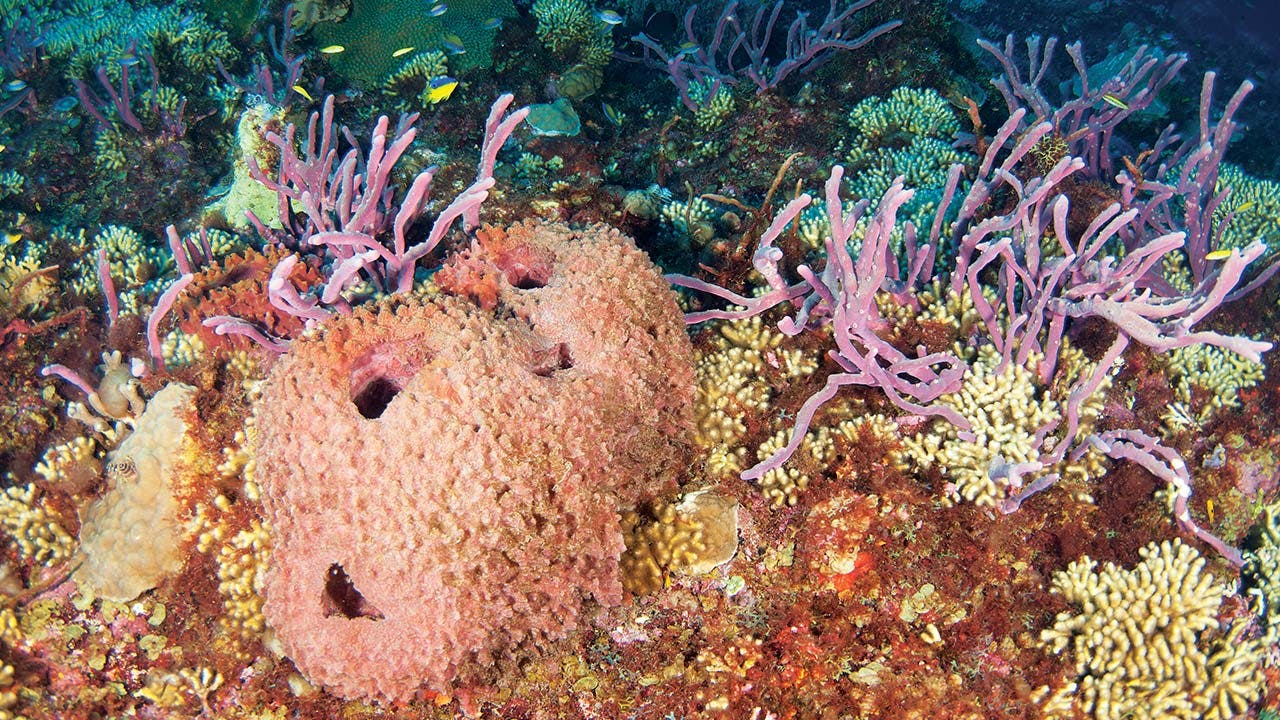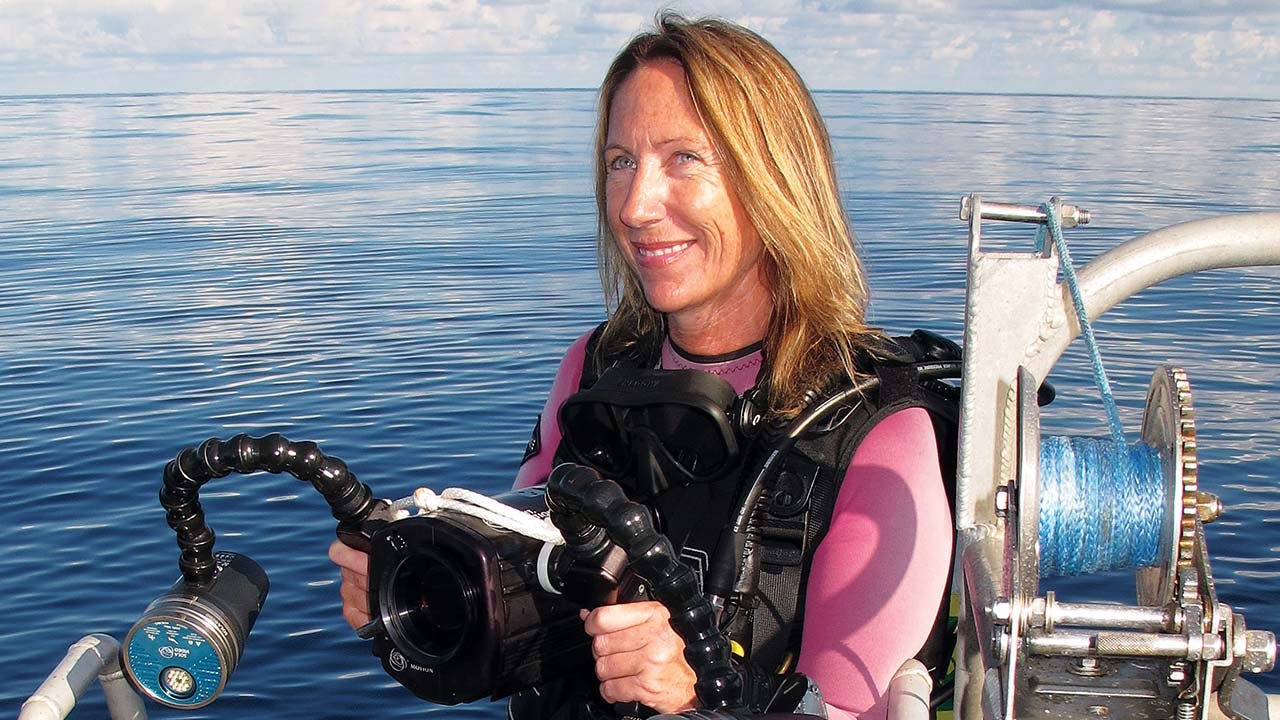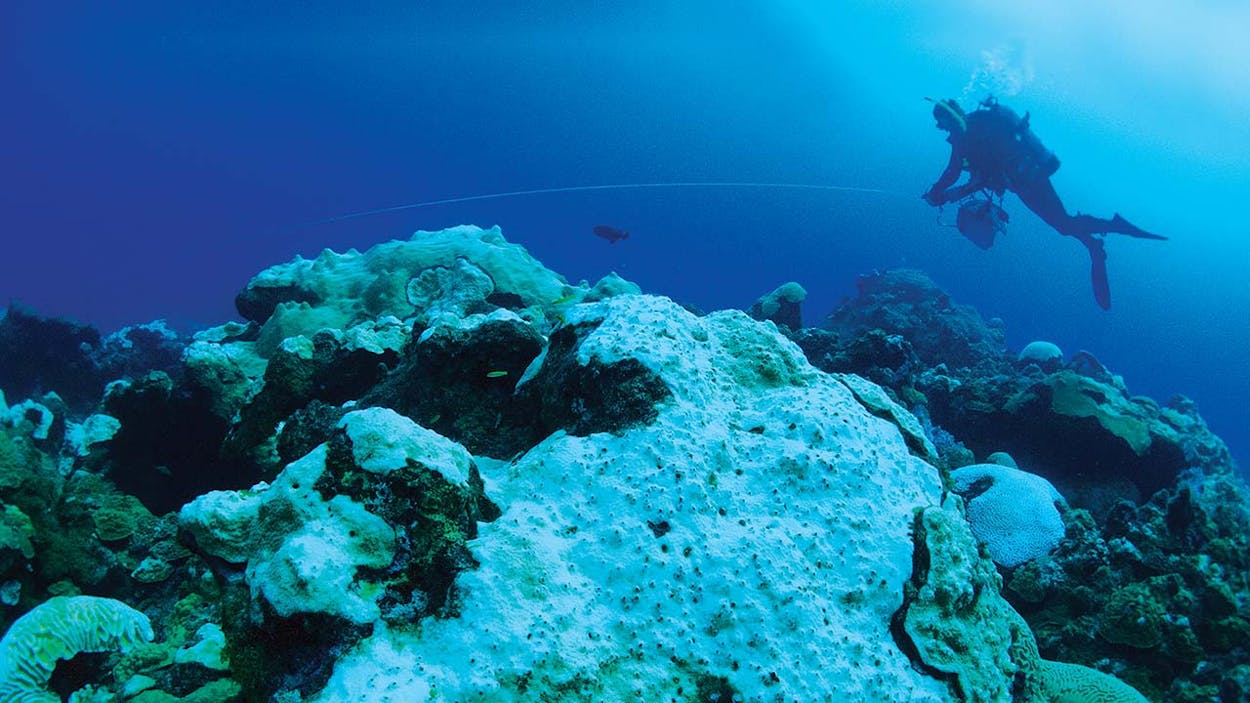Late on the afternoon of July 25, a group of recreational scuba divers on an excursion boat plunged into the water about 100 miles off Galveston to explore one of the lesser-known marvels of the Gulf Coast: the Flower Garden Banks National Marine Sanctuary, which is home to spectacular coral formations. But when the first divers got about 55 feet below the surface, they were worried by what they saw: hazy water, dead sea urchins with their spines falling out, and other dead crustaceans.
“I didn’t get in on the first dive,” recalls Cheryl Miller, a vacationing marine biologist from Florida who was onboard. “Someone came up and said, ‘There’s something going on—the water isn’t very clear.’ I went in and it was pretty devastating. The corals were sloughing their tissues. Visibility was nothing.”
Tied to a buoy not a thousand feet away sat the RV Manta, a $3.8 million research vessel that was in the middle of an annual monitoring cruise of the area. Troubled by what his passengers were saying, the captain of the dive boat, the MV Fling, radioed the Manta.
Emma Hickerson, the research coordinator of the sanctuary, who oversees the Manta’s scientific work and diving operations, was puzzled by what she heard. But she couldn’t do anything right then. The Manta had numerous monitoring lines in the water, the sea was getting rough, and the sun was going down—5:30 in the evening wasn’t a good time to pack everything up and start a new investigation. So it wasn’t until two days later that she dived in and witnessed the devastation herself. What she saw stunned her: dead and dying corals, many of them tens of centuries old, some the size of SUVs. And it was more than corals that were affected. Sponges and clams were dead and dying too. And there were no fish to be seen, which is unusual around a coral reef. “It was just shock, disbelief,” Hickerson says. “It was bizarre that two days earlier we had been sitting at buoy two, oblivious to what was going on nine hundred feet away at buoy four.”
As Hickerson and the sanctuary’s superintendent, G. P. Schmahl, swam around, they quickly realized that the affected area, which is located in the East Flower Garden Bank, one of the three areas that make up the sanctuary, stretched far beyond what the divers initially saw. Eventually, they mapped out a zone of about two hundred meters by two hundred meters that had been damaged to varying degrees. They came to call the most severely impacted area—a 6.5-acre patch, where, in places, as much as 70 percent of the corals were dead—the “hot zone,” because the corals’ skeletons were exposed, almost as if the corals had been incinerated.
And it all happened very quickly. Divers who had been out on the Fling a little more than a week before the discovery had reported nothing amiss. “A stunningly beautiful place had been devastated in less than ten days,” says Texas A&M oceanography professor Steve DiMarco. “Truly amazing.”
Alarming as all that sounds, it’s easy to overstate the damage that has occurred. By one measure, the hot zone represents about 1 percent of the sanctuary’s corals. But the loss of life is troubling. Some coral reefs are older than California’s old-growth redwood forests, and they’re an integral part of the aquatic ecosystem: they protect shorelines from storms and flooding, and they provide food, shelter, and habitat for fish and other species. They’re also critical to commercial- and sport-fishing concerns and scuba and snorkel tours. More recently, scientists have come to regard reefs as a potential source of substances with medical applications. The effects of a massive die-off of coral reefs are difficult to fathom.
One thing is for certain, though: the delicate and finicky corals beneath buoy four, whose polyps grow only about three fourths of an inch a year, won’t be coming back for generations.

As much as Texans love to brag on—and exploit—our coast, the murky waters by the shore sometimes make the Gulf look about as uninviting as the Mississippi after a big rain. But 25 or 30 miles offshore, the Gulf clears to picture-postcard blue, the stereotypical vision of the Caribbean we all carry in our heads. Well beyond that, between 70 and 115 miles out, is Flower Garden Banks.
Though it’s believed that fishermen first spotted this underwater metropolis more than a century ago, it was largely a rumor until a federal surveying team mapped out the Banks in 1936. Even for decades after that, many refused to believe that a significant reef presence was possible in the area—the waters were thought to be too cold and cloudy. But in the sixties scuba divers began mapping the area and, eventually, agitating for its designation as a national marine sanctuary. It took years, but in 1992 President George H. W. Bush granted Flower Garden Banks that status.
Thanks to the designation, the area is subject to strict protections. You can’t drop anchor there, and discharges from rigs and commercial vessels are regulated. Recently, the National Oceanic and Atmospheric Administration (NOAA) proposed that even more of the area should be safeguarded.
Today, reefs are under threat across the globe, due to overfishing, climate change, high acidity in the water, and overuse from visitors. The world’s most famous reef, the Great Barrier Reef, off Australia, has lost more than half of the corals in its northern section over the past thirty years.
As the world heats up, coral reefs will likely grow even more vulnerable. Most reefs exist symbiotically with photosynthetic algae, which give their hosts their otherworldly colors and provide as much as 90 percent of their nutrients. But when temperatures are elevated for a sustained time, the relationship turns antagonistic, with the algae poisoning the corals from the inside. In response, corals expel the algae, causing what is known as a bleaching event. The corals’ skeleton—what you see in seaside gift shops—is then visible through the tissues, although the tissue is still alive. But if the corals stay that way for an extended time, they starve and die.
For years Hickerson and her colleagues felt confident that Flower Garden Banks was relatively safe. In addition to federal protection, the remoteness of the reef has left it largely unmolested by people. Fling Charters, in Freeport, is the only recreational outfitter serving the site, and even many experienced divers don’t imagine it’s worth their time to make the trip.
Until 1993, when she was recruited to participate in a fish count at a nearby reef, the Australian-born and A&M-educated Hickerson was one of those skeptics. “As a snobby Australian I thought, ‘Why would I want to dive in the Gulf of Mexico?’ ” she says. “And I got down there and was blown away.”

Hickerson began working at the sanctuary twenty years ago as a volunteer—she actually paid a babysitter to watch her daughter so she could enjoy the privilege of offering her labor for free. In 1997 she was hired on as a part-time research coordinator and went full-time the following year. These days she keeps an office not far from the Galveston Seawall, on the second floor of NOAA’s local facility, which is housed in the decommissioned Fort Crockett. But much of her most important work is done aboard the Manta, which bunks a research team of ten and a crew of four and boasts retractable dive ladders, a 7-horsepower winch with one thousand feet of cable, wet and dry areas for analyzing samples from remotely operated underwater vehicles, and, this being Texas, a barbecue grill.
And now it’s a crime lab of sorts. Standing inside the Manta, Hickerson gestures at a map on a TV screen. “This is the hot zone,” she says, pointing to an area in red. “These are the other affected areas,” she goes on, pointing to an orange mass. “Why was it so localized? We’ve never seen something like this before.”
Since July, Hickerson and her network of specialists in academia and government have been trying to figure out what, exactly, happened to the reef. Their first task was to rule out what the culprit wasn’t, to eliminate the simple and obvious before moving on to more-exotic hypotheses. One thing Hickerson knew was that the die-off wasn’t a bleaching event—it happened too quickly and showed none of the usual signs. A few other scenarios have been excluded. In September NOAA reported that it had reviewed boat traffic in the area and found very little activity, making it highly unlikely that the die-off was caused by pollutants that had been dumped in the water. Nor does it appear to be related to the oil and gas or shipping industries, or to some sort of disease; much as dogs and cats and people can’t all catch the same cold, there’s no disease that would affect coral and sponges and sea urchins.
So what was the culprit? One possible partial explanation for the die-off may lie in this year’s weather patterns. This summer was the hottest on record; the water temperature was 87 degrees at depth when the die-off was detected. That’s 3 degrees above 84, the twenty-year average on that date and in that spot.
This past summer was also a wet one, and the runoff from the Trinity and Brazos rivers could have dumped pollutants into the Gulf and lowered the salinity. Using various data-gathering devices, A&M’s Steve DiMarco noted “uncharacteristically low salinities” in the Gulf a month before the die-off. That’s likely not a coincidence; corals need relatively salty water to thrive.
DiMarco also suspects that during the summer there was an upwelling event, a phenomenon in which water rises from below to replace surface waters that have been pushed away, typically by the wind. That would have cut off oxygen at the bottom of the reef, which would have placed further stress on it.
Sarah Davies, a coral biologist at the University of North Carolina who shipped out on the Manta in August, believes that these sorts of events would create favorable conditions for bacteria or other microorganisms, which could have then taken advantage of the reef’s vulnerable state. “I’ve never seen anything like it,” Davies says of her visit to the reef. “I’ve shown photos to people and they’re like, ‘Holy crap, what happened?’ ”
Hickerson thinks that DiMarco and Davies are essentially on the right track. She suspects it wasn’t a single cause but a series of unfortunate events that killed off the reef. She is, inevitably, put in mind of the plight of her native country’s Great Barrier Reef, which she says was a casualty of “years of insults thrown at it. It’s like a one-two punch. For reefs declining worldwide it’s not just one thing that kills them. I’m not sure we’ll ever have a definite answer about what happened here.”
Back in Galveston, data continue to dribble in, even as the investigation has been complicated by a nonlethal bleaching event in parts of the Banks. Some of the affected corals have been resistant in the past to bleaching, which suggests that they may have been weakened by whatever caused the die-off. Subsequent dives have revealed dead sponges in other areas, meaning the die-off may be more widespread than previously believed.
Since it appears that the die-off is over, though, the sanctuary has lifted its recommendation that divers stay away from the site. But Fling Charters co-owner Sharon Cain says her outfit is keeping its customers away to let the corals recover as best they can. There are plenty of other places in the area with healthy, Technicolor reefs for divers to gawk at.
Hickerson is worried about a place that is, in a sense, both her workplace and her second home. But her larger concern is a grim and global one. “Our world is mainly water,” she says. “We have to keep our oceans healthy in order to keep our species healthy. If the corals aren’t healthy, we know something’s wrong.”







